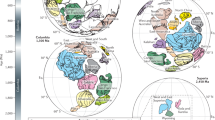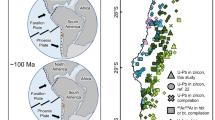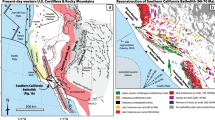Abstract
Cordilleran orogenic systems, such as the modern Andes, are long belts of deformation and magmatism that are associated with the subduction of oceanic plates beneath continental ones. Although the oceanic plates have been thought to control the evolution of such systems, a number of processes operating in the upper continental plates have not been fully accounted for. The western American Cordilleras, for example, display a 25–50 million year (Myr) cycle of linked upper-plate processes. In a typical cycle, as the two plates converge and a magmatic arc forms, most of the continental crust shortens by thrusting behind the arc, whereas the lowermost continental lithosphere is shoved beneath the arc — a process that fuels episodic high-flux magmatism in the arc and simultaneously generates dense melt residues. On reaching a critical mass, these residues sink into the mantle, creating space beneath the arc and setting the stage for renewal of the cycle. This alternative model explains key features of Cordilleran systems, such as cyclical trends in the flux and composition of magma supplied to the upper plate, and the foundering of arc roots.
This is a preview of subscription content, access via your institution
Access options
Subscribe to this journal
Receive 12 print issues and online access
$259.00 per year
only $21.58 per issue
Buy this article
- Purchase on Springer Link
- Instant access to full article PDF
Prices may be subject to local taxes which are calculated during checkout




Similar content being viewed by others
References
Anderson, J. L. in The Nature and Origin of Cordilleran Magmatism (ed. Anderson, J. L.) (Geol. Soc. Am. Mem. Vol. 174, Geological Society of America, 1990).
Pitcher, W. S. The Nature and Origin of Granite (Chapman & Hall, 1997).
Allmendinger, R. W., Jordan, T. E., Kay, S. M. & Isacks, B. L. The evolution of the Altiplano-Puna Plateau of the central Andes. Ann. Rev. Earth Planet. Sci. 25, 139–174 (1997).
Davidson, J. P. & Arculus, R. J. in Evolution and Differentiation of the Continental Crust (eds Rushmer, T. & Brown, M.) 135–172 (Cambridge Univ. Press, 2006).
Dickinson, W. R. Evolution of the Western Cordillera of North America. Ann. Rev. Earth Planet. Sci. 32, 13–45 (2004).
Schellart, W. P. Overriding plate shortening and extension above subduction zones: A parametric study to explain formation of the Andes Mountains. Geol. Soc. Am. Bull. 120, 1441–1454 (2008).
Oncken, O. et al. in The Andes: Active Subduction Orogeny (eds Oncken, O. et al.) 3–27 (Springer, 2006).
Barton, M. D. in The Nature and Origin of Cordilleran Magmatism (ed. Anderson, J. L.) 283–302 (Geol. Soc. Am. Mem. Vol. 174, Geological Society of America, 1990).
Barton, M. D. Granitic magmatism and metallogeny of southwestern North America. Trans. R. Soc. Edinb. 87, 261–280 (1996).
Ernst, W. G. in The Cordilleran Orogen: Conterminous U. S. (eds Burchfiel, B. C., Lipman, P. W. & Zoback, M. L.) 515–538 (Geological Society of America, 1992).
Hodges, K. V. & Walker, J. D. Extension in the Cretaceous Sevier orogen, North American Cordillera. Geol. Soc. Am. Bull. 104, 560–569 (1992).
DeCelles, P. G. & Coogan, J. C. Regional structure and kinematic history of the Sevier fold-and-thrust belt, central Utah. Geol. Soc. Am. Bull. 118, 841–864 (2006).
Price, R. A. & Fermor, P. R. Structure section of the Cordilleran foreland thrust and fold belt west of Calgary, Alberta. Geol. Surv. Can. Pap. 84–14 (1985).
Kay, R. W. & Kay, S. M. Creation and destruction of the lower continental crust. Geol. Rundsch. 80, 259–270 (1991).
Ducea, M. N. Constraints on the bulk composition and root foundering rates of continental arcs: A California arc perspective. J. Geophys. Res. 107, 10.1029/2001JB000643 (2002).
Lee, C. T., Cheng, X. & Horodyskyj, U. The development and refinement of continental arcs by primary basaltic magmatism, garnet pyroxenite accumulation, basaltic recharge and delamination: Insights from the Sierra Nevada, California. Contrib. Mineral. Petrol. 151, 222–242 (2006).
Sobolev, S. V., Babeyko, A., Koulakov, I. & Onken, O. in The Andes: Active Subduction Orogeny (eds Oncken, O. et al.) 513–535 (Springer, 2006).
Kley, J. & Monaldi, C. R. Tectonic shortening and crustal thickness in the Central Andes: How good is the correlation? Geology 26, 723–726 (1998).
Price, R. A. & Sears, J. W. in The Geological Environment of the Sullivan Deposit, British Columbia (eds Lydon, J. W. et al.) 61–81 (Geol. Assoc. Can., Min. Dep. Div. Spec. Vol. 1, 2000).
McQuarrie, N. The kinematic history of the central Andean fold-thrust belt, Bolivia: Implications for building a high plateau. Geol Soc. Am. Bull. 114, 950–963 (2002).
Kapp, P. et al. The Gangdese retroarc thrust belt revealed. GSA Today 17, 4–10 (2007).
Bally, A. W., Gordy, P. L. & Stewart, G. A. Structure, seismic data, and orogenic evolution of southern Canadian Rocky Mountains. Bull. Can. Petrol. Geol. 14, 337–340 (1966).
Dahlstrom, C. D. A. Structural geology of the eastern margin of the Canadian Rocky Mountains. Bull. Can. Petrol. Geol. 18, 331–406 (1970).
Boyer, S. E. & Elliott, D. Thrust systems. Bull. Am. Assoc. Petrol. Geol. 66, 1196–1230 (1982).
Oldow, J. S., Bally, A. W. & Ave Lallemant, H. G. Transpression, orogenic float, and lithospheric balance. Geology 18, 991–994 (1990).
Rogers, G. & Hawkesworth, C. J. A geochemical traverse across the North Chilean Andes: evidence for crust generation from the mantle wedge. Earth Planet. Sci. Lett. 91, 271–285 (1989).
Haschke, M., Siebel, W., Günther, A. & Scheuber, E. Repeated crustal thickening and recycling during the Andean orogeny in north Chile (21°–26°S). J. Geophys. Res. 107, 10.1029/2001JB000328 (2002).
Hyndman, R. D., Currie, C. A. & Mazzotti, S. P. Subduction zone backarcs, mobile belts, and orogenic heat. GSA Today 15, 4–10 (2005).
Kay, S. M., Coira, B. & McBride, S. Sources of late Miocene to Holocene magmas, changes in subduction geometry, and removal of crustal and mantle lithosphere beneath the southern Puna Plateau in the Central Andes. Geophys. Res. Abstr. 7, 1607 (2005).
Currie, C. A., Beaumont, C. & Huismans, R. S. The fate of subducted sediments: A case for backarc intrusion and underplating. Geology 35, 1111–1114 (2007).
Hoke, L. & Lamb, S. Cenozoic behind-arc volcanism in the Bolivian Andes, South America: Implications for mantle melt generation and lithospheric structure. J. Geol. Soc. Lond. 164, 795–814 (2007).
Ducea, M. N. & Barton, M. D. Igniting flare-up events in Cordilleran arcs. Geology 35, 1047–1050 (2007).
Zandt, G. et al. Active foundering of a continental arc root beneath the southern Sierra Nevada, California. Nature 432, 41–46 (2004).
Saleeby, J., Ducea, M. & Clemens-Knott, D. Production and loss of high-density batholithic root, southern Sierra Nevada region. Tectonics 22, 10.1029/2002TC001374 (2003).
Hamilton, W. B. Plate tectonics and island arcs. Geol. Soc. Am. Bull. 100, 1503–1527 (1988).
Davies, J. H. & Bickle, M. J. A physical model for the volume and composition of melt produced by hydrous fluxing above subduction. Phil. Trans. R. Soc. A 335, 355–364 (1991).
Grove, T. L., Parman, S. W., Bowring, S. A., Price, R. C. & Baker, M. B. The role of an H2O-rich fluid component in the generation of primitive basaltic andesites and andesites from the Mt. Shasta region, N. California. Contrib. Mineral. Petrol. 142, 375–396 (2002).
Reymer, A. & Schubert, G. Phanerozoic addition rates to the continental crust and crustal growth. Tectonics 3, 63–77 (1984).
Silver, L. T. & Chappell, B. W. The Peninsular Ranges batholith: An insight into the evolution of the Cordilleran batholiths of southwestern North America. Trans. R. Soc. Edinb. 79, 105–121 (1988).
DeBari, S. M., Evolution of oceanic and continental arc magmas: The importance of residence in the lower crust. Can. Mineral. 35, 501–519 (1997).
Armstrong, R. L. Mesozoic and early Cenozoic magmatic evolution of the Canadian Cordillera. Spec. Pap. Geol. Soc. Am. 218, 55–91 (1988).
Ghosh, D. K. Nd–Sr isotopic constraints on the interactions of the Intermontane Superterrane with the western edge of North America in the southern Canadian Cordillera. Can. J. Earth Sci. 32, 1740–1758 (1995).
Ducea, M. N. The California arc: Thick granitic batholiths, eclogitic residues, lithospheric-scale thrusting, and magmatic flare-ups. GSA Today 11, 4–10 (2001).
De Silva, S. et al. Large ignimbrite eruptions and volcano-tectonic depressions in the Central Andes: A thermomechanical perspective. Spec. Publ. Geol. Soc. (Lond.) 269, 47–63 (2006).
Babeyko, A. et al. Numerical models of crustal scale convection and partial melting beneath the Altiplano-Puna plateau. Earth Planet. Sci. Lett. 199, 373–388 (2002).
Fliedner, M. M., Klemperer, S. L. & Christensen, N. I. Three-dimensional seismic model of the Sierra Nevada arc, California, and its implications for crustal and upper mantle composition. J. Geophys. Res. 105, 10899–10921 (2000).
Lewis, J. L. et al. Regional crustal thickness variations of the Peninsular Ranges, southern California. Geology 28, 303–306 (2000).
Saleeby, J. in Exposed Cross-Sections of Continental Crust (eds Salisbury, M. H. & Fountain, D. M.) 137–158 (NATO Advanced Study Institute Series C, Vol. 317, Kluwer Academic, 1990).
Kidder, S. et al. Tectonic and magmatic development of the Salinian Coast Range Belt, California. Tectonics 22, 10.1029/2002TC001409 (2003).
Wolf, M. B. & Wyllie, P. J. Garnet growth during amphibolite anatexis: Implications of a garnetiferous restite. J. Geol. 101, 357–373 (1993).
Rapp, R. P. & Watson, E. B. Dehydration melting of metabasalts at 8–32 kbar: Implications for continental growth and crust-mantle recycling. J. Petrol. 36, 891–931 (1995).
Rushmer, T. An experimental deformation study of partially molten amphibolite: Application to low-melt fraction segregation. J. Geophys. Res. 100, 15681–15695 (1995).
Beck, S. & Zandt, G. The nature of orogenic crust in the central Andes. J. Geophys. Res. 107, 10.1029/2000JB000124 (2002).
Molnar, P., England, P. & Martinod, J. Mantle dynamics, uplift of the Tibetan Plateau, and the Indian monsoon. Rev. Geophys. 31, 357–396 (1993).
Garzione, C. N. et al. Rise of the Andes. Science 320, 1304–1307 (2008).
Davis, D., Suppe, J. & Dahlen, F. A. Mechanics of fold-and-thrust belts and accretionary wedges. J. Geophys. Res. 88, 1153–1172 (1983).
Platt, J. P. Dynamics of orogenic wedges and uplift of high-pressure metamorphic rocks. Geol. Soc. Am. Bull. 97, 1037–1053 (1986).
DeCelles, P. G. & Mitra, G. History of the Sevier orogenic wedge in terms of critical taper models, northeast Utah and southwest Wyoming. Geol. Soc. Am. Bull. 107, 454–462 (1995).
Clift, P. D. & Hartley, A. J. Slow rates of subduction erosion and coastal underplating along the Andean margin of Chile and Peru. Geology 35, 503–506 (2007).
Clift, P. D. & Vannucchi, P. Controls on tectonic accretion versus erosion in subduction zones: Implications for the origin and recycling of the continental crust. Rev. Geophys. 42, 10.1029/2003RG000127 (2004).
Lamb, S. & Davis, P. M. Cenozoic climate change as a possible cause for the rise of the Andes. Nature 425, 792–297 (2003).
Dickinson, W. R. in Tectonics of Sedimentary Basins (eds Busby, C. J. & Ingersoll, R. V.) 221–261 (Blackwell Science, 1995).
von Huene, R. & Ranero, C. R. Subduction erosion and basal friction along the sediment-starved convergent margin off Antofagasta, Chile. J. Geophys. Res. 108, 10.1029/2001JB001569 (2003).
DeCelles, P. G. & DeCelles, P. C. Rates of shortening, propagation, underthrusting, and flexural wave migration in continental orogenic systems. Geology 29, 135–138 (2001).
Kay, S. M., Coira, B. & Viramonte, J. Young mafic back-arc volcanic rocks as indicators of continental lithospheric delamination beneath the Argentine Puna plateau, Central Andes. J. Geophys. Res. 99, 24323–24339 (1994).
Asch, G. et al., in The Andes: Active Subduction Orogeny (eds Oncken, O. et al.) 443–447 (Springer, 2006).
Wells, M. L. & Hoisch, T. D. The role of mantle delamination in widespread late Cretaceous extension and magmatism in the Cordilleran orogen, western United States. Geol. Soc. Am. Bull. 120, 515–530 (2008).
Pilger, R. H. Jr Plate reconstructions, aseismic ridges, and low-angle subduction beneath the Andes. Geol. Soc. Am. Bull. 92, 448–456 (1981).
McGeary, S., Nur, A. & Ben-Avraham, Z. Spatial gaps in arc volcanism: The effect of collision or subduction of oceanic plateaus. Tectonophysics 119, 195–211 (1985).
Gutscher, M.-A., Maury, R., Eissen, J.-P. & Bourdon, E. Can slab melting be caused by flat subduction? Geology 28, 535–538 (2000).
Kay, S. M. & Abbruzzi, J. M. Magmatic evidence for Neogene lithospheric evolution of the Central Andean flat-slab between 30 and 32°S. Tectonophysics 259, 15–28 (1996).
Dickinson, W. R. & Snyder, W. S. Geometry of subducted slabs related to San Andreas transform. J. Geol. 87, 609–627 (1979).
Jordan, T. E. et al. Andean tectonics related to geometry of subducted Nazca plate. Geol. Soc. Am. Bull. 94, 341–361 (1983).
Wagner, L. S, Beck, S. & Zandt, G. Upper mantle structure in the south central Chilean subduction zone (30° to 36°S). J. Geophys. Res. 110, 10.1029/2004JB003238 (2005).
Saleeby, J. Segmentation of the Laramide slab-evidence from the southern Sierra Nevada region. Geol. Soc. Am. Bull. 115, 655–668 (2003).
Espurt, N. et al. How does the Nazca Ridge subduction influence the modern Amazonian foreland basin? Geology 35, 515–518 (2007).
Zandt, G., Gilbert, H., Jones, C. & Owens, T. Insights on lithospheric delamination from the Sierra Nevada Project (SNEP). Geol. Soc. Am. Abstr. Prog. 40, 396 (2008).
Le Pourhiet, L., Gurnis, M. & Saleeby, J. Mantle instability beneath the Sierra Nevada Mountains in California and Death Valley extension. Earth Planet. Sci. Lett. 251, 104–119 (2006).
Gilbert, H., Jones, C., Owens, T. J. & Zandt, G. Imaging Sierra Nevada lithospheric sinking. Eos 88, 10.1029/2007EO210001 (2007).
Saleeby, J. B. in Exposed Crustal Sections of the Continental Crust (eds Salisbury, M. H. & Fountain, D. M.) 137–158 (Kluwer Academic, 1990).
Camilleri, P. et al. in Proterozoic to Recent Stratigraphy, Tectonics, and Volcanology — Utah, Nevada, Southern Idaho and Central Mexico (eds Link, P. K. & Kowallis, B. J.) 297–309 (Brigham Young Univ. Geol. Studies Vol. 42, 1997).
Wyld, S. J. Structural evolution of a Mesozoic backarc fold-and-thrust belt in the U. S. Cordillera: New evidence from northern Nevada. Geol. Soc. Am. Bull. 114, 1452–1468 (2002).
Gehrels, G. E. et al. U-Th-Pb geochronology of the Coast Mountains batholith in north-coastal British Columbia: Constraints on age, petrogenesis, and tectonic evolution. Geol. Soc. Am. Bull. (in the press).
Girardi, J. D., Patchett, P. J., Ducea, M. N. & Gehrels, G. E. Geochemical characteristics of plutons emplaced in a contracting arc and evidence for the development of gravitationally unstable residual arc rocks, Coast Mountains, B. C. Eos 88, Fall Meet. Suppl. Abstr. T11B-0580 (2007).
Calkins, J. A. et al. Characterization of the crust of the Coast Mountains batholith, British Columbia, from P to S converted seismic waves and petrologic modeling. Earth Planet. Sci. Lett. (in the press).
Evenchick, C. A., McMechan, M. E., McNicoll, V. J. & Carr, S. D. in Whence the Mountains? (eds Sears, J. L. et al.) 117–145 (Geol. Soc. Am. Spec. Pap. Vol. 433, Geological Society of America, 2007).
Gubbels, T. L., Isacks, B. L. & Farrar, E. High level surfaces, plateau uplift and foreland development, Central Bolivian Andes. Geology 21, 695–698 (1993).
Echavarria, L., Hernandez, R., Allmendinger, R. W. & Reynolds, J. Subandean thrust and fold belt of northwestern Argentina: Geometry and timing of the Andean evolution. Bull. Am. Assoc. Petrol. Geol. 87, 965–985 (2003).
Elger, K., Oncken, O. & Glodny, J. Plateau-style accumulation of deformation: Southern Altiplano. Tectonics 24, TC4020 (2005).
Gillis, R. J., Horton, B. & Grove, M. Thermochronology, geochronology, and upper crustal structure of the Cordillera Real: Implications for Cenozoic exhumation of the Central Andean Plateau. Tectonics 25, TC6007 (2006).
Gregory-Wodzicki, K. M. Uplift history of the central and northern Andes: A review. Geol. Soc. Am. Bull. 112, 1091–1105 (2000).
Chmielowski, J., Zandt, G. & Haberland, C. The central Andean Altiplano-Puna magma body. Geophys. Res. Lett. 26, 783–786 (1999).
Yuan, X., Sobolev, S. V. & Kind, R. Moho topography in the central Andes and its geodynamic implications. Earth Planet. Sci. Lett. 199, 389–402 (2002).
Zandt, G. et al. Seismic detection and characterization of the Altiplano-Puna magma body, central Andes. Pure Appl. Geophys. 160, 789–807 (2003).
Ege, H. et al. Thrust-related exhumation revealed by apatite fission track dating, Central Andes (southern Bolivia). Geophys. Res. Abstr. 3, 624 (2001).
Heit, B. et al. An S receiver function analysis of the lithospheric structure in South America. Geophys. Res. Lett. 34, L14307 (2007).
Coira, B. & Kay, S. M. Implications of Quaternary volcanism at Cerro Tuzgle for crustal and mantle evolution of the Puna plateau, Central Andes, Argentina. Contrib. Mineral. Petrol. 113, 40–58 (1993).
Kendrick, E. et al. Active orogeny of the south-central Andes studied with GPS geodesy. Rev. Assoc. Geol. Argentina 61, 555–566 (2006).
Pindell, J. L., Higgs, R. & Dewey, J. F. in Paleogeographic Evolution and Non-glacial Eustasy, Northern South America (eds Pindell, J. L. & Drake, C. L.) 45–86 (SEPM Spec. Publ. 58, Society for Sedimentary Geology, 1998).
Lithgow-Bertelloni, C. & Gurnis, M. Cenozoic subsidence and uplift of continents from time-varying dynamic topography. Geology 25, 735–738 (1997).
Acknowledgements
We thank S. Kay, M. D. Barton, S. L. Beck, B. Carrapa, S. A. Graham, W. R. Dickinson, G. E. Gehrels, A. Leier, J. Kendall, M. McGroder, G. Gray, R. Barke, T. Demko, C. Garzione, D. Pearson, numerous graduate students, and participants in the University of Arizona Andes Seminar for discussions and insights into Cordilleran systems. We thank J. Girardi and J. Patchett for access to isotopic data from the Coast Mountains batholith. Financial support for research leading to this paper was provided by ExxonMobil and NSF EAR programmes (Tectonics, Earthscope, Geophysics and Continental Dynamics). We thank B. S. Currie, S. Ellis, and R. V. Ingersoll for thoughtful reviews that helped us to improve the manuscript.
Author information
Authors and Affiliations
Corresponding author
Rights and permissions
About this article
Cite this article
DeCelles, P., Ducea, M., Kapp, P. et al. Cyclicity in Cordilleran orogenic systems. Nature Geosci 2, 251–257 (2009). https://doi.org/10.1038/ngeo469
Published:
Issue Date:
DOI: https://doi.org/10.1038/ngeo469
This article is cited by
-
Quantitative characterization of orogens through isotopic mapping
Communications Earth & Environment (2023)
-
Growth of Neogene Andes linked to changes in plate convergence using high-resolution kinematic models
Nature Communications (2022)
-
Cycles of Andean mountain building archived in the Amazon Fan
Nature Communications (2022)
-
Rapid surface uplift and crustal flow in the Central Andes (southern Peru) controlled by lithospheric drip dynamics
Scientific Reports (2022)
-
Interplay between oceanic subduction and continental collision in building continental crust
Nature Communications (2022)



